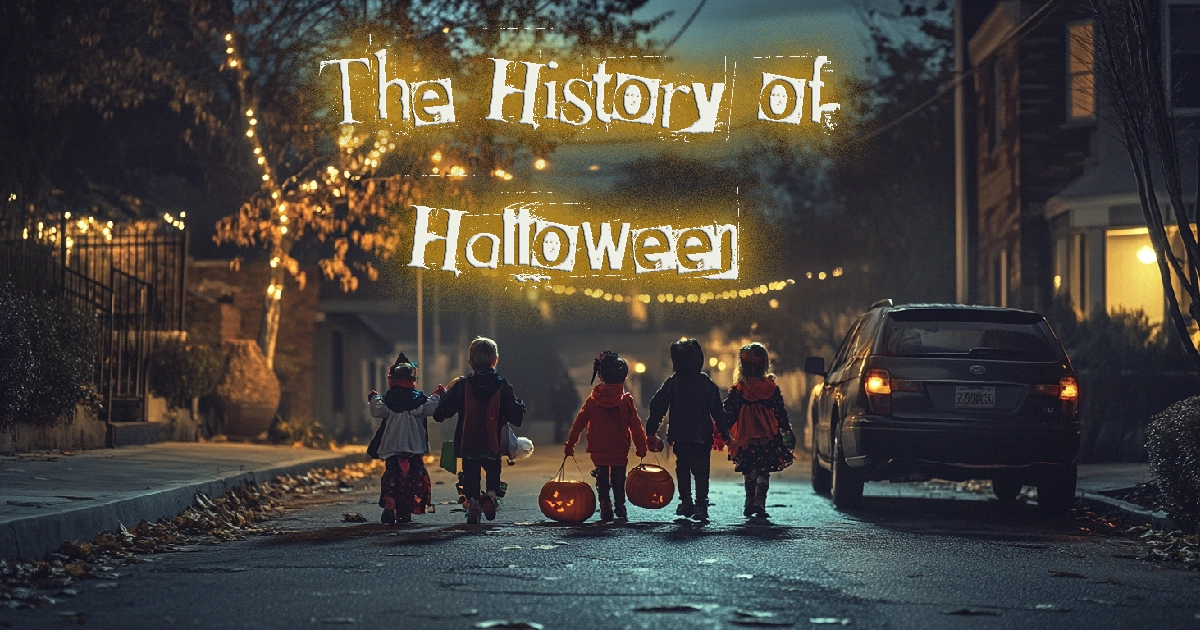

Halloween is a night of mystery, fun, and fright, but its origins are far more interesting than just trick-or-treating or dressing up in costumes. This spooky holiday has traveled through centuries, blending cultures and traditions to become the celebration we know today. So, grab your broomstick and follow along as we explore the history of Halloween!
Our journey into the history of Halloween begins over 2,000 years ago with the ancient Celts, a civilization that thrived in what we now call Ireland, the United Kingdom, and northern France. These early people followed a cyclical calendar, deeply connected to the natural world and the changing of the seasons. For them, the transition from October to November was more than just a shift in weather—it marked the beginning of their new year.
This important time of year was celebrated with a festival known as Samhain (pronounced “Sow-in”), which took place on the night of October 31st. Unlike modern New Year’s Eve, Samhain wasn’t about fireworks and celebrations. It was a time of reflection, a period of mystery when the lines between the natural and supernatural world were thought to blur.
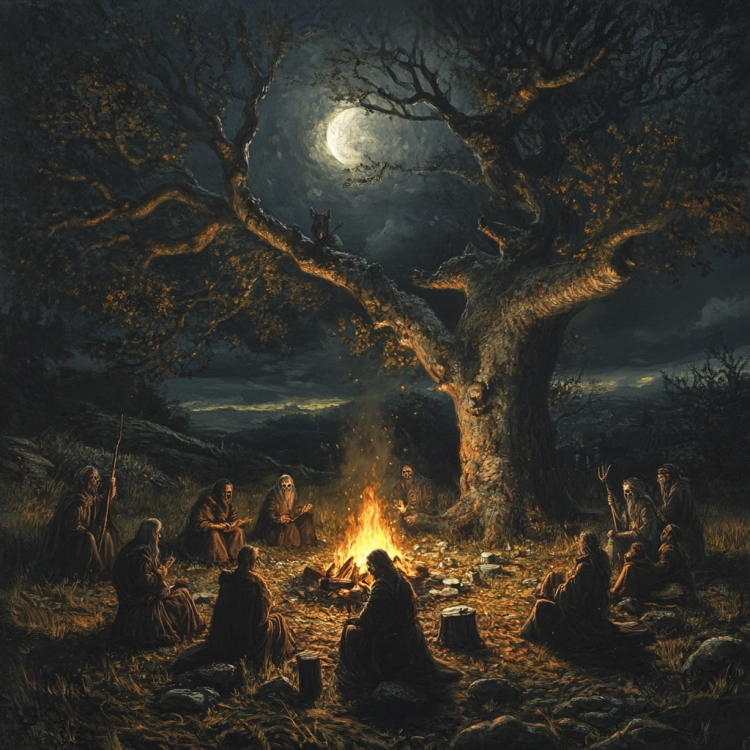
Samhain signaled the end of the harvest season and the arrival of the cold, dark winter. Life for the Celts was heavily dependent on their crops, and the successful completion of the harvest meant the difference between life and death during the long winter months. As the crops were gathered and stored, it was time to look ahead to the challenges that winter would bring.
For the Celts, winter was the season of death—a time when the sun seemed to retreat and the land grew barren. Samhain was a way to acknowledge this change and to prepare spiritually for the months of hardship ahead. The festival also marked the final, symbolic harvesting of life itself, as it was believed that the boundary between the world of the living and the dead was at its thinnest during Samhain.
As the Roman Empire expanded its reach across Europe, it didn’t just conquer lands—it absorbed the cultures and traditions of the people who lived there. When the Romans took control of the Celtic territories around 43 AD, they encountered the long-standing celebration of Samhain. Rather than replacing the Celtic festival, Roman traditions began to merge with it, leading to the early foundations of what would later become Halloween.
One of the most significant Roman influences on Samhain came from Feralia, a festival dedicated to the spirits of the dead. Held in late October, Feralia was the final day of Parentalia, a longer Roman festival that honored deceased ancestors. During this time, the Romans believed the spirits of their loved ones would visit the earth. To ensure their peace, the living would offer prayers, sacrifices, and food at family tombs and burial sites.
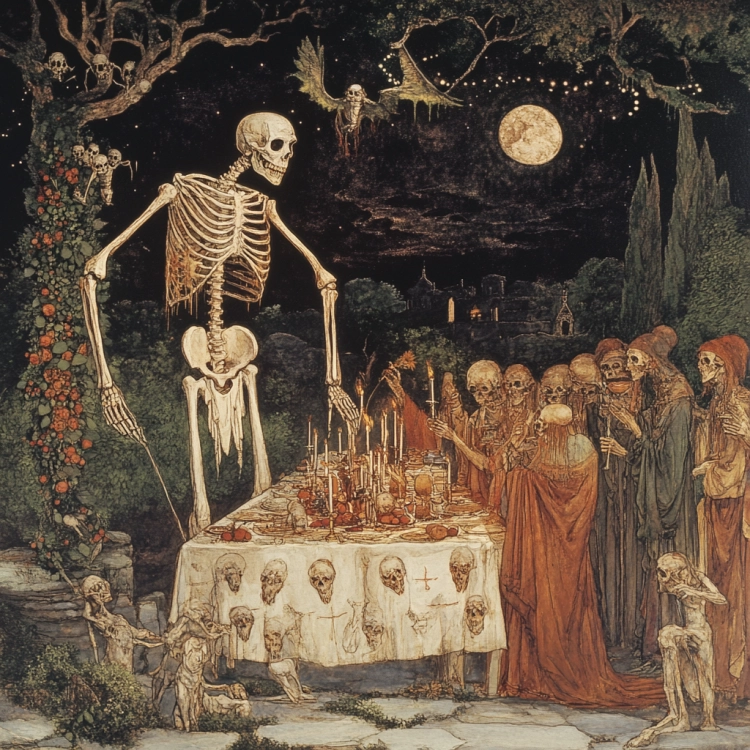
This tradition of honoring the dead during autumn naturally blended with the Celtic belief that spirits crossed over during Samhain. Over time, both cultures came to accept the idea that the late October period was a time when the veil between the living and the dead was at its thinnest. The Romans brought with them the notion of reverence for ancestral spirits, which layered perfectly with the spiritual nature of Samhain.
The second Roman festival that influenced Halloween was a celebration of Pomona, the Roman goddess of fruit, trees, and abundance. While Feralia focused on the dead, Pomona’s festival, which took place around the same time, was more lighthearted. It celebrated the bounty of the harvest, with apples being especially sacred to Pomona, as they symbolized fertility, health, and abundance.
The Celts, who were already celebrating the end of the harvest during Samhain, adopted some elements of this Roman festival. Apples, which were abundant in both Roman and Celtic lands, became a key symbol in the merging of traditions. This is likely how the practice of bobbing for apples—a popular Halloween game—came to be. In Roman times, apples were often used in divination games to predict a person's future, especially in matters of love. For example, it was said that the first person to successfully bite into an apple while bobbing would be the next to marry.
As these Roman festivals merged with Samhain, the blending of cultures led to the evolution of the holiday. Samhain’s focus on the supernatural—the belief that spirits and ghosts were crossing over into the world of the living—mixed with the Roman’s more structured rituals for honoring the dead. Feralia, with its focus on respecting deceased ancestors, likely reinforced the Celtic tradition of leaving out offerings of food to pacify wandering spirits.
Meanwhile, Pomona’s association with the harvest and fruit trees added a symbolic richness to Samhain’s existing harvest customs. Apples, already an important crop, became intertwined with both rituals of protection and light-hearted games, such as apple-bobbing and apple-peeling competitions to predict romantic futures. These playful customs endured, even as the holiday itself continued to evolve over the centuries.
The Roman influence on Samhain didn’t just leave behind symbols and rituals—it played a significant role in shaping the way we think about the autumn season and its connection to both life and death. The merging of Feralia’s focus on honoring the dead with Samhain’s spiritual traditions cemented the importance of this time of year as one where the worlds of the living and the dead overlap.
Pomona’s festival, while more focused on nature and the harvest, left a lasting legacy as well. The apple, a symbol of Pomona’s blessings, would go on to be a key part of Halloween festivities. Even today, the apple appears in games and traditions during Halloween, a reminder of how ancient Roman customs have quietly influenced the way we celebrate this spooky season.
This blend of Roman and Celtic beliefs would, over time, be further transformed by the spread of Christianity, but the core elements of death, harvest, and nature have remained central to the celebration. It’s a fascinating look at how two different worlds—the mystical Celts and the disciplined Romans—came together to shape what we now know as Halloween.
As Christianity spread across Europe, church leaders sought to replace pagan holidays with Christian ones. In the 9th century, Pope Gregory III designated November 1st as All Saints’ Day—also known as All Hallows’ Day—dedicated to saints and martyrs. The night before, October 31st, became known as All Hallows’ Eve, which eventually morphed into Halloween.
All Hallows’ Eve kept many of the ancient traditions alive, but they now had a Christian twist. People would still dress in costumes, but instead of fearing spirits, they went door-to-door asking for food in exchange for prayers for the dead, a practice that resembles modern-day trick-or-treating.
Halloween didn’t become popular in the United States until the 19th century, when Irish immigrants escaping the Potato Famine brought their customs with them. The Irish and Scottish traditions of "guising" (going door-to-door in costumes) became a favorite among children in America. Over time, this evolved into the trick-or-treating we know today.
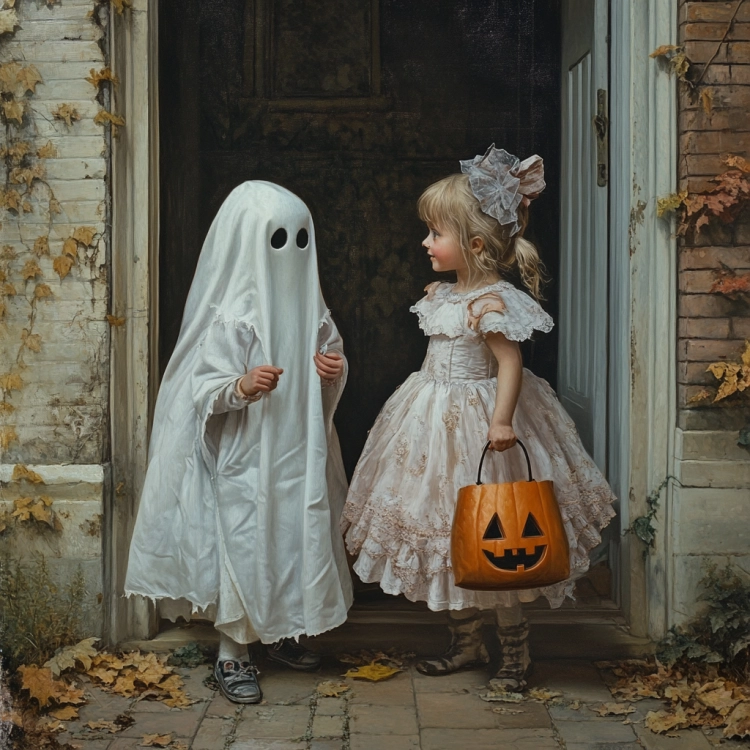
By the 1920s and 1930s, Halloween became a community-centered holiday in America, complete with parades and town-wide parties. However, it wasn’t until the 1950s that trick-or-treating took off as we know it today. Post-World War II, the baby boom meant more children than ever before, and neighborhoods became the perfect place for kids to go door-to-door in search of candy.
No Halloween story would be complete without the mention of the iconic jack-o’-lantern. But did you know this tradition comes from an old Irish legend about a man named Stingy Jack? As the story goes, Jack tricked the Devil into not taking his soul, but when he died, neither Heaven nor Hell would accept him. Jack was left to wander the Earth with only a carved-out turnip to light his way. The Irish began carving scary faces into turnips to ward off Jack’s wandering spirit.
When the tradition came to America, pumpkins—native to North America—became the preferred choice for jack-o’-lanterns. They were bigger and easier to carve than turnips, and so the tradition took on a new, pumpkin-flavored life.
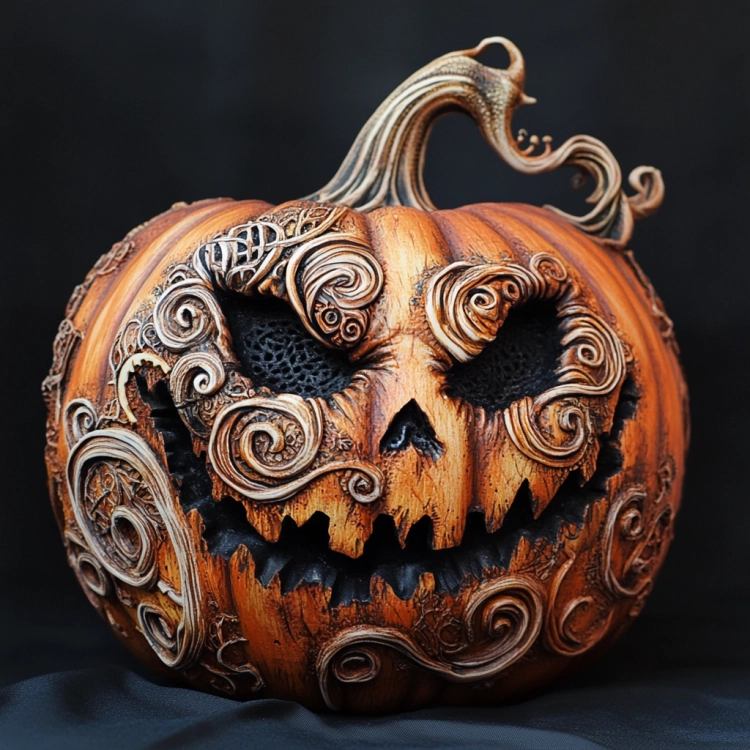
In the past, Halloween costumes were designed to frighten away evil spirits, but today, costumes come in all forms—scary, funny, and even cute. The focus has shifted from warding off spirits to simply having fun and expressing creativity.
And what would Halloween be without candy? Believe it or not, candy wasn’t always part of the holiday. It wasn’t until the 1950s that candy manufacturers saw an opportunity and began marketing small, individually wrapped treats for trick-or-treaters. Now, millions of pounds of candy are sold each year just for Halloween!
Another popular Halloween tradition is the haunted house. Though the idea of haunted houses has been around for centuries, the first organized haunted houses appeared in the United States during the 1930s. Today, haunted attractions have grown into elaborate, thrilling experiences designed to give visitors a good scare.
Though Halloween is most widely celebrated in the United States with trick-or-treating, spooky decorations, and haunted houses, the holiday has left its mark on many different cultures across the globe. From honoring the dead in colorful festivals to adopting modern, Western customs, countries around the world have their own unique ways of marking this special time of year. Let’s take a look at how Halloween—or something like it—is celebrated in various parts of the world.
In Mexico, Halloween coincides with the vibrant and deeply meaningful holiday known as Día de los Muertos or the Day of the Dead. This celebration, which lasts from October 31st to November 2nd, is all about remembering and honoring deceased loved ones. But unlike Halloween’s focus on fear and spookiness, Día de los Muertos is a joyous occasion where the dead are invited to join the living in celebration.
Families create altars (ofrendas) in their homes, decorated with photos, candles, marigold flowers, and offerings of food and drinks to welcome the spirits back to the world of the living. Traditional foods like pan de muerto (bread of the dead) and sugar skulls (calaveras) are offered as gifts, and cemeteries are transformed with colorful decorations, music, and family gatherings. People also paint their faces like skeletons, especially the Calavera Catrina, a well-known image of a female skeleton in elegant clothing.
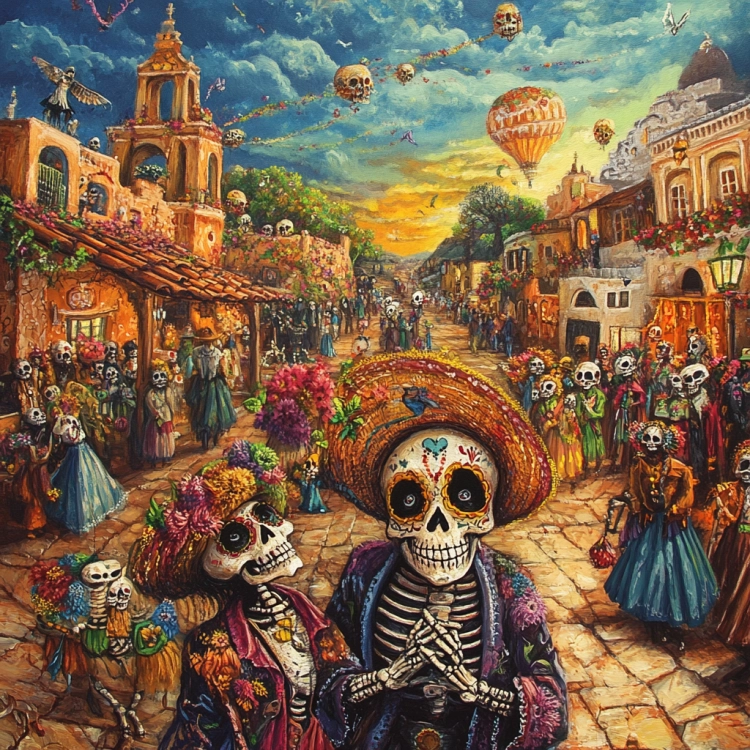
While Día de los Muertos is distinct from Halloween, the two share some similarities, such as honoring the dead and engaging with symbols of mortality. The holiday has even influenced some American Halloween customs, especially in communities with large Mexican populations.
Ireland and Scotland, where Halloween first began as the Celtic festival of Samhain, continue to celebrate the holiday with a mix of old and new traditions. In these countries, Halloween is still called Oíche Shamhna in Irish and Oidhche Shamhna in Scottish Gaelic, reminding people of the festival's ancient origins.
In Ireland, many of the traditional customs of Halloween, such as bonfires, dressing up in costumes, and playing pranks, are still practiced today. Children go from house to house asking for treats, much like in the United States, but the traditional practice of “guising” (dressing in disguise to trick spirits) still holds strong. Bobbing for apples and other Halloween games also remain popular, reflecting the influence of the Roman goddess Pomona.
In Scotland, the tradition of guising is also alive and well, with children performing songs, poems, or jokes in exchange for sweets. A uniquely Scottish tradition is the making of turnip lanterns—carved turnips with spooky faces to ward off spirits. Though pumpkins have largely replaced turnips due to their size and ease of carving, many Scots still hold on to this older, more traditional practice.
In the United Kingdom, Halloween has become increasingly popular, though for many years it took a back seat to another autumnal celebration: Guy Fawkes Night (or Bonfire Night) on November 5th. Guy Fawkes Night commemorates the failed Gunpowder Plot of 1605, where Fawkes and his co-conspirators attempted to blow up the British Parliament. Traditionally, the night is celebrated with fireworks, bonfires, and the burning of effigies of Guy Fawkes.
However, in recent years, Halloween has gained ground, and it’s now common to see children trick-or-treating and houses decorated with ghosts, witches, and pumpkins. Costume parties and spooky events, often held in historic locations, are also a big part of the Halloween scene in the UK. Haunted attractions, inspired by American traditions, have become increasingly popular, and people often explore old castles and stately homes believed to be haunted.
In Japan, Halloween has taken on a unique, Kawaii (cute) spin. Though Halloween wasn’t traditionally celebrated in Japan, it has grown in popularity, especially in urban areas like Tokyo. The holiday first gained traction in the late 1990s, largely thanks to Disneyland and Universal Studios Japan, which host large, colorful Halloween-themed events each year.
In Japan, Halloween is less about trick-or-treating and more about costumes and parades. People, both children and adults, love dressing up as their favorite characters from anime, movies, and games, giving the holiday a very cosplay-centric vibe. Streets in Tokyo’s famous Shibuya district turn into a lively costume parade, with thousands of people showing off their elaborate and creative outfits.
While Japan has adopted many of Halloween’s fun elements, the deeper connection to spirits and the dead is less prominent. Instead, it’s become a festive and family-friendly event where creativity and costumes are at the heart of the celebration.
In Germany, Halloween is celebrated with a twist. Though it’s still a relatively new holiday, it has been growing in popularity, particularly among young people who enjoy dressing up in costumes and attending Halloween-themed parties. Pumpkin festivals, especially in rural areas, have also become popular.
However, Halloween in Germany is closely followed by All Saints’ Day on November 1st, which is a more solemn occasion to honor the dead by visiting cemeteries and leaving flowers on graves. In some parts of the country, Reformation Day is celebrated on October 31st, marking the anniversary of Martin Luther’s posting of the 95 Theses, which sparked the Protestant Reformation.
In some regions of Germany, particularly the more religious ones, Halloween is viewed with skepticism because of its pagan and commercialized nature. Despite this, it’s becoming increasingly common to see Halloween decorations, costumes, and parties in major cities.
In the Philippines, Halloween is part of the larger celebration known as Undas, which combines All Saints' Day (November 1st) and All Souls' Day (November 2nd). Much like Día de los Muertos in Mexico, Undas is a time to honor deceased family members. Families clean and decorate the graves of their loved ones, offering flowers, candles, and prayers.
Before Halloween was popularized in the Philippines, a local tradition called Pangangaluluwa was practiced. In this custom, groups of people would go from house to house, often dressed in white or as souls of the dead, singing songs to collect prayers and offerings for the departed. Though Pangangaluluwa has faded over time, it is making a comeback in some rural areas as people seek to reconnect with their heritage.
Halloween is a holiday that has evolved and transformed over thousands of years. From the ancient festival of Samhain to the candy-filled night we know today, it’s a celebration that blends the mystical and the fun. So, whether you’re carving pumpkins, trick-or-treating, or visiting a haunted house, remember that you’re taking part in a tradition that’s been around for centuries—and that’s pretty magical!